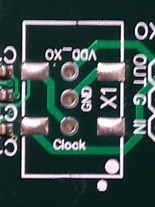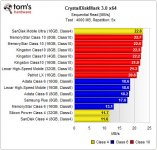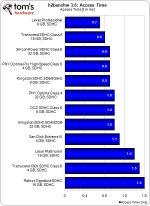Song List when testing DSD256
Hi Arthur (PHEONIX)
Just to give you an indication of the sound tracks we used for listening. Sorry that the description may be incomplete and I do not have the time to go further right now since I am just before a longer business trip abroad ;-) All music are from CDs or downloaded files that we either have purchased or received explicit permission to use (in some cases sample files made available by recording company):
CARD#1 (16GB)
Kreisler- Praeludium and Allegro.dff
Mozart Sinfonia Concertante in E-flat major K.364 (320d) - I. Allegro maestoso.dff
Rimsky-Korsakov Dance of the Tumblers.dff
Symphony No.5 1st movement.dff
Beethoven-Sonate_32-2L-049-SACD.dff
Jen Chapin - Big Brother.dff (original Chesky 192kHz/24bit file)
Love feeling.dff
My Love.dff
Ole_Bull-Concert Fantastico-2L-067-SACD.dff
Primera Fila - Thalia.dff (Mexican artist recorded by Sony Music)
Sigmund Groven & Iver Kleive: harmOrgan 2L-077-stereo-DXD_02.dff (original DXD 352.8kHz/24bit file)
Hugh Masekela - Stimela (The Coal Train).dff
Jack Johnson - Brushfire Fairytales - 01 Inaudible Melodies.dff
CARD#2 (16GB)
DSD-1bit Consortium (1bit Audio Consortium Web Page) at Waseda University, Tokyo
01-DSD64_21kr01_2ch.dff (violin)
02-DSD128_22kr01_5_6M_2ch.dff (violin)
03-DSD256_2006_nagano_ohba.dff (violin)
DSD-West Side Story (unique recording from East Europe)
DSD128-W_S_Story_05.dff
DSD256_W_S_Story_05.dff
Pink Floyd - Dark Side of The Moon (CD)
CD-04-Time.wav
DSD64-04 - Pink Floyd - Time.dff
DSD128-04 - Pink Floyd - Time.dff
DSD256-04 - Pink Floyd - Time.dff
Duo Sotanas
CD-04. M Haydn , Duo for violin and viola No 1 in C major MH335 - Allegro.wav
DSD64-04 - Haydn Duo in C Allegro.dff
DSD128-04 - Haydn Duo in C Allegro.dff
DSD256-04 - Haydn Duo in C Allegro.dff
Kari Bremnes Live (CD)
CD-Kari Bremnes - Live -05- Sangen om fyret ved Tornehamn.wav
DSD256-Kari Bremnes - Live -05- Sangen om fyret ved Tornehamn.dff
Tsai Chin (CD)
CD-04 Love me again - Tsai Chin.wav
DSD256-04 Love me again - Tsai Chin.dff
Hiromi Iwasaki (CD)
CD-My Love.wav
CD-My Love.dff
Hi Arthur (PHEONIX)
Just to give you an indication of the sound tracks we used for listening. Sorry that the description may be incomplete and I do not have the time to go further right now since I am just before a longer business trip abroad ;-) All music are from CDs or downloaded files that we either have purchased or received explicit permission to use (in some cases sample files made available by recording company):
CARD#1 (16GB)
Kreisler- Praeludium and Allegro.dff
Mozart Sinfonia Concertante in E-flat major K.364 (320d) - I. Allegro maestoso.dff
Rimsky-Korsakov Dance of the Tumblers.dff
Symphony No.5 1st movement.dff
Beethoven-Sonate_32-2L-049-SACD.dff
Jen Chapin - Big Brother.dff (original Chesky 192kHz/24bit file)
Love feeling.dff
My Love.dff
Ole_Bull-Concert Fantastico-2L-067-SACD.dff
Primera Fila - Thalia.dff (Mexican artist recorded by Sony Music)
Sigmund Groven & Iver Kleive: harmOrgan 2L-077-stereo-DXD_02.dff (original DXD 352.8kHz/24bit file)
Hugh Masekela - Stimela (The Coal Train).dff
Jack Johnson - Brushfire Fairytales - 01 Inaudible Melodies.dff
CARD#2 (16GB)
DSD-1bit Consortium (1bit Audio Consortium Web Page) at Waseda University, Tokyo
01-DSD64_21kr01_2ch.dff (violin)
02-DSD128_22kr01_5_6M_2ch.dff (violin)
03-DSD256_2006_nagano_ohba.dff (violin)
DSD-West Side Story (unique recording from East Europe)
DSD128-W_S_Story_05.dff
DSD256_W_S_Story_05.dff
Pink Floyd - Dark Side of The Moon (CD)
CD-04-Time.wav
DSD64-04 - Pink Floyd - Time.dff
DSD128-04 - Pink Floyd - Time.dff
DSD256-04 - Pink Floyd - Time.dff
Duo Sotanas
CD-04. M Haydn , Duo for violin and viola No 1 in C major MH335 - Allegro.wav
DSD64-04 - Haydn Duo in C Allegro.dff
DSD128-04 - Haydn Duo in C Allegro.dff
DSD256-04 - Haydn Duo in C Allegro.dff
Kari Bremnes Live (CD)
CD-Kari Bremnes - Live -05- Sangen om fyret ved Tornehamn.wav
DSD256-Kari Bremnes - Live -05- Sangen om fyret ved Tornehamn.dff
Tsai Chin (CD)
CD-04 Love me again - Tsai Chin.wav
DSD256-04 Love me again - Tsai Chin.dff
Hiromi Iwasaki (CD)
CD-My Love.wav
CD-My Love.dff
Last edited:
my nice new Sandisk ultra 30mb/s SDHC was not recognized....@001 format error.
I should say three points on SDHC memory cards;
1. What "Class" means
A "Class number" denotes a maximum speed of "WRITING" in Mbps. If you want a rapid writing, it's better for you to select a memory card of higher class number.
2. What is important for SDTrans
A speed of "READ" is critical for plays on SDTrans. Its limit is determined in principal by the method of readout adopted by SDTrans. Not by the "Class" property of the card.
3. The use of Class 10
They say some devices are not compatible to this class because the "Class 10" was added later. This might also apply to "Ultra".
Please understand such complicated situations for SDHC memory compatibility.
In my case, I usually select "Silicon Power" class 4 or class 6 as their prices are very reasonable.
I should say three points on SDHC memory cards;
1. What "Class" means
A "Class number" denotes a maximum speed of "WRITING" in Mbps. If you want a rapid writing, it's better for you to select a memory card of higher class number.
2. What is important for SDTrans
A speed of "READ" is critical for plays on SDTrans. Its limit is determined in principal by the method of readout adopted by SDTrans. Not by the "Class" property of the card.
3. The use of Class 10
They say some devices are not compatible to this class because the "Class 10" was added later. This might also apply to "Ultra".
Please understand such complicated situations for SDHC memory compatibility.
In my case, I usually select "Silicon Power" class 4 or class 6 as their prices are very reasonable.
Thanks for the clarification Bunpei,
This is just an initial test and not a problem.
Is just follow your sugestion for class 4 or 6
Edit: just checked Sandisk Ultra is C6 !!! but does not work.
The one i have that is working is Sandisk C2.
Last edited:
Hi Bunpei,
It makes sense that for SDtrans read speed is what matters, I'll try a few others.
here is very interesting group test at "Tom's hardware"
It is still not clear to me if response time of the SDHC card is also critical for SDtrans, this parameter also varies a lot and is not directly related to Class classification.
Here is Silicon power class 4 read speed and a access time comparison test:
It makes sense that for SDtrans read speed is what matters, I'll try a few others.
here is very interesting group test at "Tom's hardware"
It is still not clear to me if response time of the SDHC card is also critical for SDtrans, this parameter also varies a lot and is not directly related to Class classification.
Here is Silicon power class 4 read speed and a access time comparison test:
Attachments
Last edited:
Dear SDTrans users and those who made payment and has not received any shipping notice,
This is on holiday seasons in Japan. I am away from my residence. My usual e-mail connection is off-line now. I only maintain a web access.
If you need any urgent communications with me, please send a PM on this forum to me.
Best regards,
Bunpei
This is on holiday seasons in Japan. I am away from my residence. My usual e-mail connection is off-line now. I only maintain a web access.
If you need any urgent communications with me, please send a PM on this forum to me.
Best regards,
Bunpei
I have a few more cards, going to test these today and then will see.
Funny thing is that the SanDisk Ultra C6 that does not play in SDtrans has gorgeous sound in my car's Mp3 player...it's not all bad.
The cards i'll be testing today are:
SONY SDHC C4 16G
LEXAR SDHC C4 32G
Samsung SDHC C10 16G
Kingston SDHC C4 16G
will let you guys know.
Funny thing is that the SanDisk Ultra C6 that does not play in SDtrans has gorgeous sound in my car's Mp3 player...it's not all bad.
The cards i'll be testing today are:
SONY SDHC C4 16G
LEXAR SDHC C4 32G
Samsung SDHC C10 16G
Kingston SDHC C4 16G
will let you guys know.
Announcement on release of sync-option sub board kit release
This week, I have sent an announcement e-mail to SDTrans users who made their reservations before for the sync-option sub boards.
If any of you have not received it yet, please drop your usual Internet e-mail to Bunpei.
This week, I have sent an announcement e-mail to SDTrans users who made their reservations before for the sync-option sub boards.
If any of you have not received it yet, please drop your usual Internet e-mail to Bunpei.
Play of 48kHz series DSD sources
Chiaki made an enhancement on DSD play.
Now you can play DSD DFF files of 48 kHz series by updating firmware.
Namely, play of DSD64(3.1MHz), DSD128(6.2MHz), DSD256(12.4MHz).
No FPGA configuration EEPROM update is required.
If you need the firmware update, please contact to Bunpei.
Chiaki made an enhancement on DSD play.
Now you can play DSD DFF files of 48 kHz series by updating firmware.
Namely, play of DSD64(3.1MHz), DSD128(6.2MHz), DSD256(12.4MHz).
No FPGA configuration EEPROM update is required.
If you need the firmware update, please contact to Bunpei.
Hello staccatiss.I have about 20 pcs of SDCARDs and with these
* SanDisk SDHC 2, 4, 8, 16GB class 2,4, and 6
* SanDisk Ultra 16GB class4
* SanDisk Extreme III class 62GB
* Kingston SDHC 32GB class 4
I have no problems using SDTrans384 with the 3.1 software (not DSD FPGA yet).
/S
You have Pm.
Mats
How to detach an oscillator device from Buffalo III DAC main board
We recommend the use of SDTrans384 I2S/DSD output with ES9018 DAC in a "synchronous master clock configuration".
In order to implement this on TPA Buffalo III board, an original Crystek crystal oscillator device must be detached from Buffalo III main board. Here I explain the easiest and the most secure way based on my experiences of processing more than 10 cases.
Plan A . Applying four well-heated soldering irons at the same time to the four soldered points of the Crystek SMD oscillator device on board
. Applying four well-heated soldering irons at the same time to the four soldered points of the Crystek SMD oscillator device on board
It's the most simple and secure way. However, you need both four irons and four hands. A veteran DIY audiophile may have four irons. He may need a help of one of his family members as well.
Plan B . Applying low melting point temperature solder material to the four spots
. Applying low melting point temperature solder material to the four spots
Actually, this method does not go so well as imagined.
Plan C . Inserting thin knife edge between the base board of the oscillator and main board of Buffalo III to prize out, applying a soldering iron to the nearest soldering spot one by one
. Inserting thin knife edge between the base board of the oscillator and main board of Buffalo III to prize out, applying a soldering iron to the nearest soldering spot one by one
This method probably may damage tiny land patterns printed on bottom side of oscillator base board.
We recommend the use of SDTrans384 I2S/DSD output with ES9018 DAC in a "synchronous master clock configuration".
In order to implement this on TPA Buffalo III board, an original Crystek crystal oscillator device must be detached from Buffalo III main board. Here I explain the easiest and the most secure way based on my experiences of processing more than 10 cases.
Plan A
It's the most simple and secure way. However, you need both four irons and four hands. A veteran DIY audiophile may have four irons. He may need a help of one of his family members as well.
Plan B
Actually, this method does not go so well as imagined.
Plan C
 . Inserting thin knife edge between the base board of the oscillator and main board of Buffalo III to prize out, applying a soldering iron to the nearest soldering spot one by one
. Inserting thin knife edge between the base board of the oscillator and main board of Buffalo III to prize out, applying a soldering iron to the nearest soldering spot one by oneThis method probably may damage tiny land patterns printed on bottom side of oscillator base board.
Connecting MCLK of SDTrans to Buffalo III
After you remove the Crystek Crystal Oscillator unit on your Buffalo III main board, you will find the following printed patterns on the board.

You can connect MCLK pin output of CN8 on SDTrans384 to the "Clock" through hole. You can select one of two MCLK output frequency classes, 22.5792/24.576MHz or by 90.3168/98.304MHz by setting SMD jumpers. When JP1 and JP5 are shunted, 90.3168/98.304MHz MCLK multiplied in FPGA appears on HDMI connector and I2S CN8 pin header respectively. JP2 and JP6 for 22.5792/24.576MHz MCLK tapped from raw output lines of NDK oscillators.
When you favor OSF OFF setting of ES9018, 22.5792/24.576MHz MCLK is enough. When you play DSD sources or DXD sources in OSF ON setting, you must select 90.3168/98.304MHz MCLK configuration.
In the case of using Sync-option, you must connect MCLK output pin at CN6 on DAC-side sub board to the "Clock" through hole on Buffalo III main board and GND pin at CN6 to "GND" through hole.
An adequate MCLK frequency is automatically selected by SDTrans firmware based on detected fs, 44.1kHz series or 48kHz series, of the currently selected source file.
After you remove the Crystek Crystal Oscillator unit on your Buffalo III main board, you will find the following printed patterns on the board.

You can connect MCLK pin output of CN8 on SDTrans384 to the "Clock" through hole. You can select one of two MCLK output frequency classes, 22.5792/24.576MHz or by 90.3168/98.304MHz by setting SMD jumpers. When JP1 and JP5 are shunted, 90.3168/98.304MHz MCLK multiplied in FPGA appears on HDMI connector and I2S CN8 pin header respectively. JP2 and JP6 for 22.5792/24.576MHz MCLK tapped from raw output lines of NDK oscillators.
When you favor OSF OFF setting of ES9018, 22.5792/24.576MHz MCLK is enough. When you play DSD sources or DXD sources in OSF ON setting, you must select 90.3168/98.304MHz MCLK configuration.
In the case of using Sync-option, you must connect MCLK output pin at CN6 on DAC-side sub board to the "Clock" through hole on Buffalo III main board and GND pin at CN6 to "GND" through hole.
An adequate MCLK frequency is automatically selected by SDTrans firmware based on detected fs, 44.1kHz series or 48kHz series, of the currently selected source file.
Hello
For the first time SDTrans has been featured by a general on-line High End Audio publication: HiFi Statement in Germany run by Dirk Sommer who is also engaged in recording of music:
DSD, ein Format mit Zukunft? ? Zweiter Teil inklusive DSD-Download
For the first time SDTrans has been featured by a general on-line High End Audio publication: HiFi Statement in Germany run by Dirk Sommer who is also engaged in recording of music:
DSD, ein Format mit Zukunft? ? Zweiter Teil inklusive DSD-Download
Hi, emuman100,
I appreciate your interest on Chiaki's SD memory card player.
To our regret, we have no stock so far and no definite plan for the next release.
If you just need an SPDIF output and don't need hi-res I2S nor DSD output, an alternative low cost Chinese product might meet your requirements.
Bunpei
I appreciate your interest on Chiaki's SD memory card player.
To our regret, we have no stock so far and no definite plan for the next release.
If you just need an SPDIF output and don't need hi-res I2S nor DSD output, an alternative low cost Chinese product might meet your requirements.
Bunpei
- Home
- Source & Line
- Digital Source
- MicroSD Memory Card Transport Project

